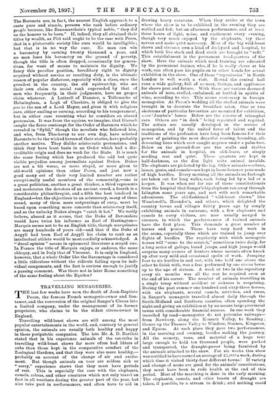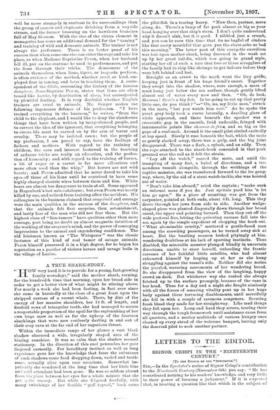TRAVELLING MENAGERIES.
THE last few weeks have seen the death of Jean-Baptiste Pezon, the famous French menagerie-owner and lion- tamer, and the conversion of the original Sanger's Circus into a limited company, under the management of its former proprietor, who claims to be the oldest circus-owner in England.
Travelling wild-beast shows are still among the most popular entertainments in the world, and, contrary to general opinion, the animals are usually both healthy and happy in these peripatetic companies: The late Mr. A. D. Bartlett stated that in his experience animals of the cat-tribe in travelling wild-beast shows far more often had litters of cubs than those kept in the comparative comfort of the Zoological Gardens, and that they were also more healthy,— probably on account of the change of air and excite- ment. Bat though animals on tour are seldom sick or "-sorry," experience shows that they must have periods of rest. This is especially the case with the elephants, camels, zebras, and other creatures which not only travel on foot in all weathers during the greater part of the year, but also take part in performances, and often have to aid in
drawing heavy caravans. When they arrive at the town where the show is to be exhibited in the evening they are stabled and fed ; bat an afternoon performance, and at least three hours of light, noise, and excitement every evening, though very much enjoyed by the elephants, try their nerves and make quiet necessary. Most of the big wild-beast shows and circuses own a kind of dockyard and hospital, to which both live stock and dead stock are brought to "refit." This establishment is the permanent headquarters of the show. Here the animals which need training are educated by the permanent trainer, who, if he is really clever at his work, can often pass his pupils on to other hands for actual exhibition in the show. One of these "repositories " in North London is well worth a visit. Round the central hall runs a wide gallery, full of scenery, fittings, and appliances for shows past and future. With these are various deceased animals of note, stuffed, embalmed, or bottled in spirits of wine, according to size. This seems customary in foreign menageries. At Pezon's wedding all the stuffed animals were brought in to decorate the breakfast salon. One or two skeletons of particular favourites are mounted for exhibition. more `Jumbo's' bones. Below are the reserve of triumphal cars. Others are " in dock " being repainted and regilded. The artists are usually developed in the service of menageries, and by the united force of talent and the traditions of the profession have long been famous for their power of painting the most dreadful roaring, bounding, all- devouring lions which ever caught negroes under a palm-tree. Below on the ground-floor are the stalls and stables for the animals in hospital, on sick-leave, or simply needing rest and quiet. These quarters are kept in half-darkness, as the dim light suits animal invalids. The elephants are picketed by the leg. Other animals—zebras, lamas, goats, and camels—are kept in loose-boxes or pens made of high hurdles. Every morning all the animals on furlough are taken out for long walks, each being led by a lad or a keeper. It was when out for one of these constitutionals from the hospital that Sanger's big elephant ran away through Islington some years ago, and met with such remarkable adventures. The old-fashioned " wild-beast shows," like Wombwell's, Maunder's, and others, which delighted the country towns and villages thirty years ago by simply exhibiting animals in caravans, with a few elephants and camels to carry visitors, are now usually merged in circuses, in which the performances of trained animals have the first place. This demands a great number of horses and ponies. These have very hard work in the arena, especially those which are trained to jump over flights of hurdles. The regularity with which menagerie horses will "come to the scratch," sometimes twice daily, for a long series of gallops, broad jumps, and high jumps would surprise many owners of hunters whose mounts often knock up after very mild and occasional spells of work. Jumping four to six hurdles in and out, with two held one above the other to finish with, was a feat performed by one circus horse up to the age of sixteen. A week or two in the repository every six months was all the rest he required even at the end of his career. The number of animals travelling in a single troop without accident or sickness is surprising. During the past summer one hundred and sixty-three horses, with six elephants, several camels, ostriches, and emus, in Sanger's menagerie travelled almost daily through the South-Midland and Southern counties, often spending the night and giving an exhibition at by no means large provincial towns with considerable financial success. In one week they travelled by road—menageries do not patronise railways— from Newbury, along the Kennett Valley, to Reading ; thence up the Thames Valley to Windsor, Staines, Kingston, and Epsom. At each place they gave two performances, in the morning and evening, besides making the journey. All the scenery, vans, and material of a huge tent large enough to hold ten thousand people, were packed and transported, the draught-power being furnished by the animals attached to the show. For six weeks this show was certified to have earned an average of £1,000 a week, during which time it visited thirty-four different towns ! If variety and change of scene are good for the animals' constitutions, they must have been in rude health at the end of this period. Most of the marching is done in the early morning. The elephants, camels, and other beasts of draught are taken, if possible, to a stream to drink ; and nothing could
well be more strangely in contrast to its surroundings than the group of camels and elephants driukiug from a wayside stream, and the former browsing on the hawthorn branches full of May blossom. With the rise of the circus element in menageries has come an additional demand for the " taming" and training of wild and domestic animals. The trainer is not always the performer. There is no better proof of his success than when some one else can enter the cage and take his place, as when Madame Baptistine Pezon, when her husband fell ill, put on the costume he used in performances, and put the lions through their tricks. The demeanour of the animals themselves, when lions, tigers, or leopards perform, is often evidence of the method, whether cruel or kind, em- ployed first in taming, and later in teaching them. A corre- spondent of the Globe, recounting the history of the famous dompteur, Jean-Baptiste Pezon, states that lions are often tamed like hawks, by deprivation of sleep, but accompanied by plentiful feeding. It is very doubtful whether English trainers are cruel to animals. Mr. Sanger makes the following ingenuous defence of his profession. "I have trained everything in the business," he writes, "from the child to the elephant, and I would like to deny the slanderous things that have been written by inexperienced people, and to correct the idea of the ignorant, that everything belonging to circus life must be carried on by the arm of terror and cruelty. There may be isolated cases ; but the people of my profession, I am proud to say, have the feelings of fathers and mothers. With regard to the training of children, the care and interest bestowed in the teaching of arduous tricks are really an education, and the perfec- tion of humanity ; and with regard to the training of horses, a bit of sugar or a carrot is far more efficacious and more often used than the whip." But horses are not wild beasts ; and Pezon admitted that he never dared to take his eyes off those of his lions until he contrived to have some highly charged electric wires between them and him. White bears are almost too dangerous to train at all. Some appeared in Hagenbeck's last sale-catalogue ; but even Pezon was nearly killed by one, and retired from training after the accident. His colleagues in the business claimed that sang-froid and courage were the main qualities in the success of the dompteur, and that the animals felt first surprise, then astonishment, and lastly fear of the man who did not fear them. But the highest class of " lion-tamers " have qualities other than mere courage, part being no doubt an almost magnetic intuition of the working of the creature's mind, and the power of conveying impressions to the animal and engendering confidence. The old Irishman known as " The Whisperer " was the classic instance of this kind of real tamer of savage animals. Pezon himself possessed it in a high degree, for he began his reputation as a pacifier of vicious horses and savage bulls in the village of Lozere.























































 Previous page
Previous page